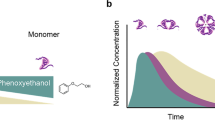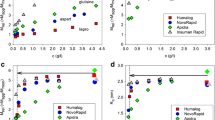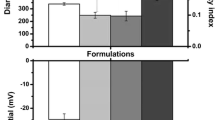Abstract
Formation of covalent, higher molecular weight transformation (HMWT) products during storage of insulin preparations at 4–45°C was studied by size exclusion chromatography. The main products are covalent insulin dimers (CID), but in protamine-containing preparations the concurrent formation of covalent insulin-protamine (CIP) products takes place. At temperatures ≥25°C parallel or consecutive formation of covalent oligo- and polymers can also be observed. Rate of HMWT is only slightly influenced by species of insulin but varies with composition and formulation, and for isophane (NPH) preparations, also with the strength of preparation. Temperature has a pronounced effect on CID, CIP, and, especially, covalent oligo- and polymer formation. The CIDs are apparently formed between molecules within the hexameric unit common for all types of preparations and rate of formation is generally faster in glycerol-containing preparations. Compared with insulin hydrolysis reactions (see the preceding paper), HMWT is one order of magnitude slower, except for NPH preparations.
Similar content being viewed by others
REFERENCES
J. Brange, L. Langkjær, S. Havelund, and A. Vølund. Chemical stability of insulin. 1. Hydrolytic degradation during storage of pharmaceutical preparations. Pharm Res. 9:715–726 (1992).
J. Schlichtkrull, M. Pingel, L. G. Heding, J. Brange, and K. H. Jørgensen. Insulin preparations with prolonged effect. In A. Hasselblatt and F. von Bruchhausen (eds.), Handbook of Experimental Pharmacology, New Series, Vol. XXXII/2, Springer-Verlag, Berlin, Heidelberg, New York, 1975, pp. 729–777.
J. Brange, L. Langkjær, S. Havelund, and E. Sørensen. Chemical stability of insulin: Neutral insulin solutions. Diabetologia 25:193 (1983) (abstr).
J. Brange, L. Langkjær, S. Havelund, and E. Sørensen. Chemical stability of insulin: Formation of covalent insulin dimers and other higher molecular weight transformation products in intermediate-and long-acting insulin preparations. Diabetologia 27:259A–260A (1984) (abstr).
J. Brange, B. Skelbaek-Pedersen, L. Langkjaer, U. Damgaard, H. Ege, S. Havelund, L. G. Heding, K. H. Jørgensen, J. Lykkeberg, J. Markussen, M. Pingel, and E. Rasmussen. Galenics of Insulin: The Physico-chemical and Pharmaceutical Aspects of Insulin and Insulin Preparations, Springer-Verlag, Berlin, Heidelberg, New York, London, Paris, Tokyo, 1987.
D. F. Steiner, O. Hallund, A. Rubenstein, S. Cho, and C. Bayliss. Isolation and properties of proinsulin, intermediate forms, and other minor components from crystalline bovine insulin. Diabetes 17:725–736 (1968).
D. F. Steiner. Proinsulin and the biosynthesis of insulin. N. Engl. J. Med. 280:1106–1113 (1969).
H.-J. Helbig. Insulindimere aus der b-Komponente von Insulinpräparationen, Dissertation, Rheinish-Westfälishe Technische Hochschule, Aachen, 1976.
T. R. Csorba, H. G. Gattner, and P. Cuatrecasas. Partial dimerization of insulin. Clin. Res. 20:918 (1972) (abstr).
J. Brange. Insulin transformation products formed during storage of insulin preparations: Isolation, characterization and properties (in preparation).
J. Brange, D. R. Owens, S. Kang, and A. Vølund. Monomeric insulins and their experimental and clinical implications. Diabetes Care 13:923–954 (1990).
J. T. Carstensen. Drug Stability: Principles and Practices, Dekker, New York and Basel, 1990.
E. N. Baker, T. L. Blundell, J. F. Cutfield, S. M. Cutfield, E. J. Dodson, G. G. Dodson, D. M. C. Hodgkin, R. E. Hubbard, N. W. Isaacs, C. D. Reynolds, K. Sakabe, N. Sakabe, and N. M. Vijayan. The structure of 2Zn pig insulin crystals at 1.5 Å resolution. Phil. Trans. R. Soc. 319:369–456 (1988).
J. F. Back, D. Oakenfull, and M. B. Smith. Increased thermal stability of proteins in the presence of sugars and polyols. Biochemistry 18:5191–5196 (1979).
K. Gekko and S. N. Timasheff. Mechanism of protein stabilization by glycerol: Preferential hydration in glycerol-water mixtures. Biochemistry 20:4667–4676 (1981).
U. Derewenda, Z. Derewenda, E. J. Dodson, G. G. Dodson, C. D. Reynolds, G. D. Smith, C. Sparks, and D. Swenson. Phenol stabilizes more helix in a new symmetrical zinc insulin hexamer. Nature 338:594–596 (1989).
J. Brange, S. Havelund, P. Hansen, L. Langkjær, E. Sørensen, and P. Hildebrandt. Formulation of physically stable neutral solutions for continuous infusion by delivery systems. In J. L. Gueriguian, E. D. Bransome, and A. S. Outschoorn (eds.), Hormone Drugs, US Pharmacopoeial Convention, Rockville, MD, 1982, pp. 96–105.
A. S. Acharya and J. M. Manning. Reaction of glycolaldehyde with proteins: Latent crosslinking potential of α-hydroxyaldehydes. Proc. Natl. Acad. Sci. USA 80:3590–3594 (1983).
J. Bello and H. R. Bello. Chemical modification and crosslinking of proteins by impurities in glycerol. Arch. Biochem. Biophys. 172:608–610 (1976).
M. C. Manning, K. Patel, and R. T. Borchardt. Stability of protein pharmaceuticals. Pharm. Res. 6:903–918 (1989).
D. C. Robbins, S. M. Cooper, S. E. Fineberg, and P. M. Mead. Antibodies to covalent aggregates of insulin in blood of insulin-using diabetic patients. Diabetes 36:838–841 (1987).
M. Maislos, P. M. Mead, D. H. Gaynor, and D. C. Robbins. The source of the circulating aggregate of insulin in type I diabetic patients is therapeutic insulin. J. Clin. Invest. 77:717–723 (1986).
R. E. Ratner, T. M. Phillips, and M. Steiner. Persistent cutaneous insulin allergy resulting from high-molecular-weight insulin aggregates. Diabetes 39:728–733 (1990).
L. J. Nell and J. W. Thomas. Frequency and specificity of protamine antibodies in diabetic and control subjects. Diabetes 37:172–176 (1988).
Author information
Authors and Affiliations
Additional information
To whom correspondence should be addressed at Nove Research Institute, Novo Alle, DK-2880Bagsvaerd, Denmark
Rights and permissions
About this article
Cite this article
Brange, J., Havelund, S. & Hougaard, P. Chemical Stability of Insulin. 2. Formation of Higher Molecular Weight Transformation Products During Storage of Pharmaceutical Preparations. Pharm Res 9, 727–734 (1992). https://doi.org/10.1023/A:1015887001987
Issue Date:
DOI: https://doi.org/10.1023/A:1015887001987




